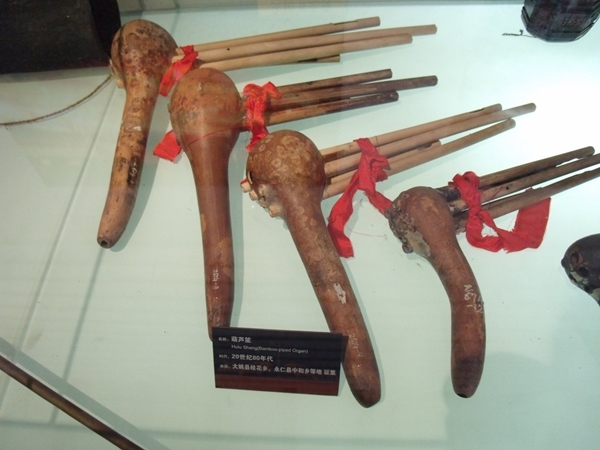Playing skills of calabash
The structure of the gourd sheng is roughly the same as that of the sheng, consisting of a sheng bucket and a sheng tube. It is named after the Shengdou is made of empty gourd.

When playing the gourd sheng, hold the sheng with both hands and press the hole with your fingers. Each pipe of the gourd sheng can emit two tones with different heights, and the interval is the relationship between the minor second, the major second or the minor third. Press the sound hole on the pipe with your finger, you can make the basic sound, that is, the high pitch in the interval, and plug the mouth of the pipe exposed at the bottom of the pipe with your finger, and the bottom of the pipe can emit a changing sound, that is, the bass in the interval. . Therefore, although a calabash sheng has five, six or eight pipes, it can produce ten, twelve or sixteen sounds.
The sound of the five-pipe gourd Sheng is as follows: the first pipe is bb, c1, the second pipe is be1, f1, the third pipe is f1, g1, the fourth pipe is ba1, b1, and the fifth pipe is bb1, c2. The sounds of the eight-pipe gourd are as follows: a1, #a1, b1, #c2, #c2, d2, #d2, f2, e2, f2, f2, g2, g2, a2, g2, #a2. Take the five-pipe gourd Sheng as an example, the thumb of the left hand presses the upper hole of the second pipe, the index finger presses the top hole of the first pipe, the ring finger presses the top hole of the third and fourth pipes, the right index finger presses the top hole of the fifth pipe, and the thumb presses both. Bottom holes of each tube below the bucket. For a six- or seven-pipe gourd sheng, the index finger of the right hand presses the upper hole of the last pipe, and the middle finger presses the upper hole of the fifth or sixth pipe. Breathing and breathing can be pronounced.
The pronunciation of the press holes on the gourd pipe is mostly used to play the melody or to play two-tone, three-tone or four-tone harmony and chords. Gently rubbing the mouth of the bottom end of the pipe with your fingers, you can also play a slight and round decorative glissando, which is often used to set off the melody or play a fixed rhythm.
 渝公网安备 50010702504639号
渝公网安备 50010702504639号